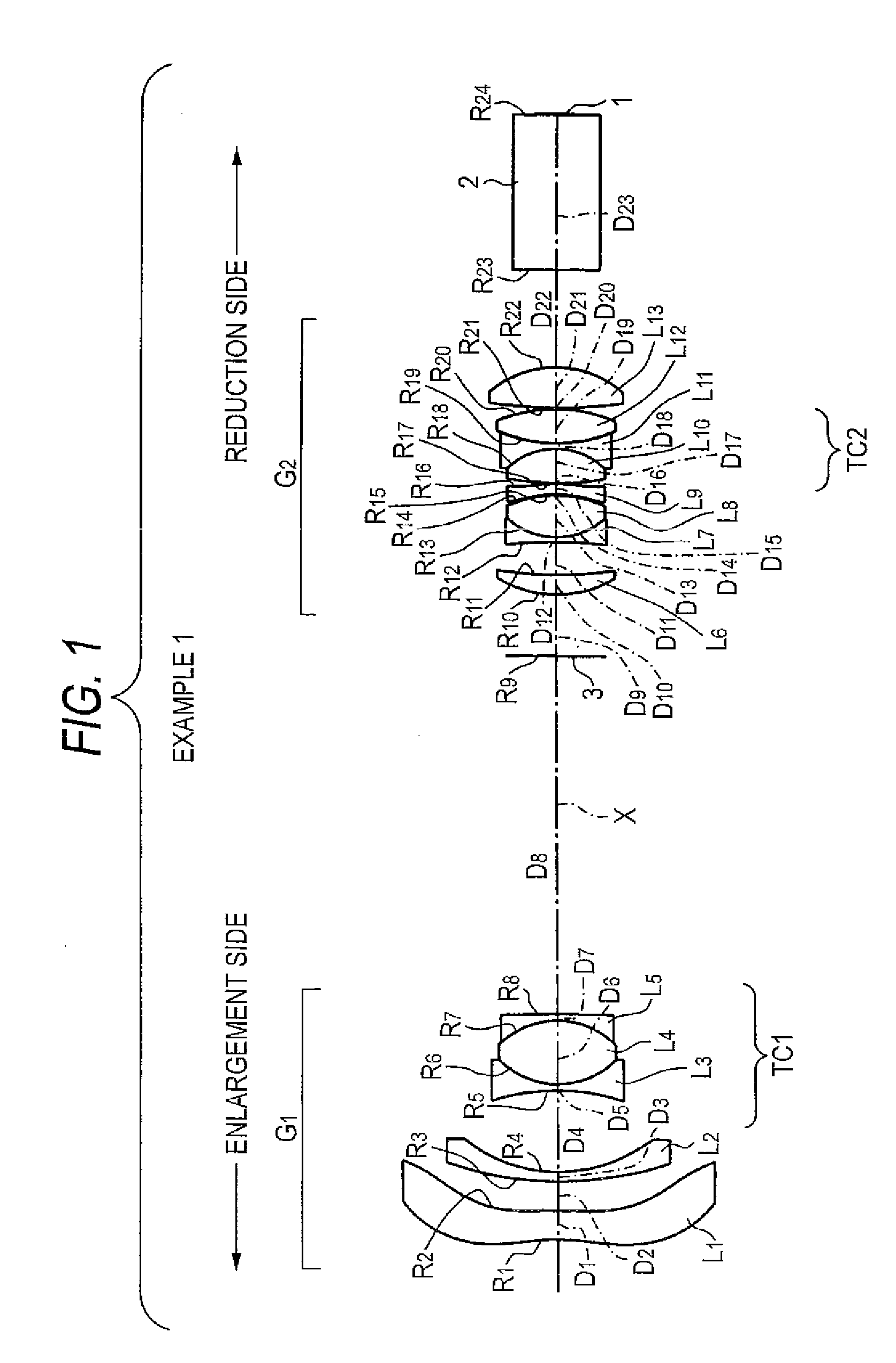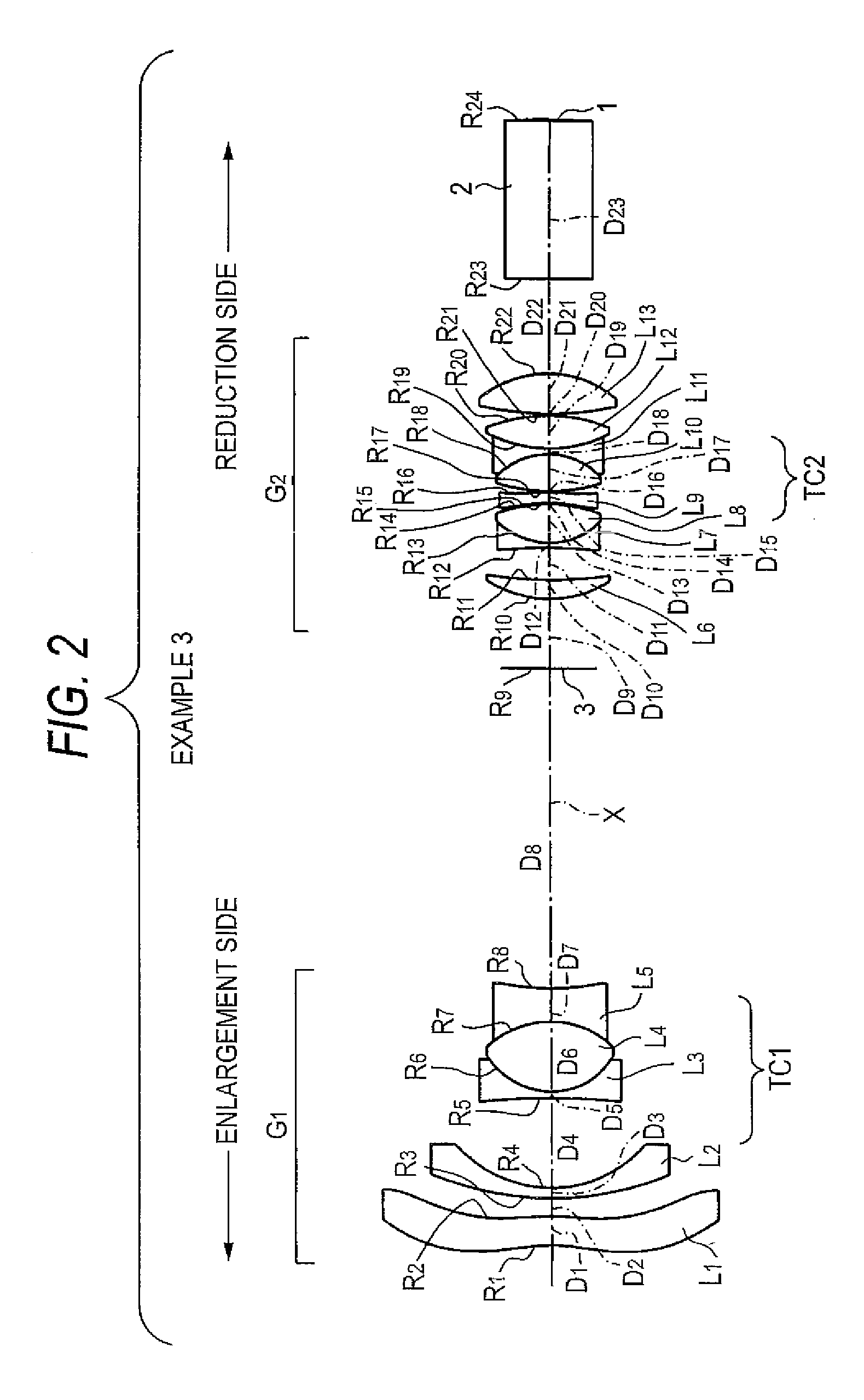Projection lens
- Summary
- Abstract
- Description
- Claims
- Application Information
AI Technical Summary
Benefits of technology
Problems solved by technology
Method used
Image
Examples
example 1
[0086]As shown in FIG. 1, the projection lens of Example 1 includes the first lens group G1 having negative refractive power, the aperture diaphragm 3, and the second lens group G2 having positive refractive power, which are arranged in order from the enlargement side. The reduction side of the projection lens is made essentially telecentric.
[0087]In the first lens group G1, the first lens L1 formed from an aspherical lens whose convex surface is oriented toward the enlargement side, the second lens L2 formed from a negative meniscus lens whose concave surface is oriented toward the reduction side, and the cemented triplet lens TC1 formed by sandwiching the fourth lens L4 formed from one biconvex lens between the third and fifth lenses L3 and L5 are arranged in order from the enlargement side.
[0088]In the meantime, in the second lens group G2, there are arranged the sixth lens L6 formed from a positive meniscus lens whose convex surface is oriented toward the enlargement side, the s...
example 2
[0101]A projection lens of Example 2 is essentially identical in configuration to a projection lens of Example 3 which is shown in FIG. 2 and which will be described later. FIG. 2 is used as an example overview, and explanations about common elements are omitted.
[0102]Specifically, in the projection lens of Example 1, the fifth lens L5 is embodied as a negative meniscus lens whose concave surface is oriented toward the enlargement side. In contrast, the present example and subsequent examples differ from Example 1 in that the fifth lens L5 is embodied by a biconcave lens. In other respects, all of the examples have a common basic configuration.
[0103]An upper row of Table 3 shows a value of a radius of curvature R of each of lens surfaces of the projection lens of Example 2, a value of on-axis surface spacing D of each of the lenses, a value of a refractive index Nd achieved along d-line of each of the lenses, and a value of an Abbe number νd achieved along d-line of each of the lens...
example 3
[0106]A projection lens of Example 3 is as shown in FIG. 2. The projection lens is essentially identical in configuration to the projection lens of Example 1, and explanations of common elements are omitted.
[0107]An upper row of Table 5 shows a value of a radius of curvature R of each of lens surfaces of the projection lens of Example 3, a value of on-axis surface spacing D of each of the lenses, a value of a refractive index Nd achieved along d-line of each of the lenses, and a value of an Abbe number νd achieved along d-line of each of the lenses. Lower rows of Table 5 show a projection distance (spacing between a conjugate position on the enlargement side and the first surface of the lens).
TABLE 5Focal Length F = 1.00Surface Nos.RDNdνd 1*−7.2871.1731.4910057.6 2*−12.9240.734 312.8610.4211.8466623.8 45.1993.657 5−27.4760.2611.7130053.9 63.0852.8171.6398034.5 7−3.8551.3411.8040046.6 810.98413.033 9 (STO)∞2.857104.6690.7781.8466623.81116.9851.31212−21.4730.2091.8040046.6133.0741.567...
PUM
 Login to View More
Login to View More Abstract
Description
Claims
Application Information
 Login to View More
Login to View More - R&D
- Intellectual Property
- Life Sciences
- Materials
- Tech Scout
- Unparalleled Data Quality
- Higher Quality Content
- 60% Fewer Hallucinations
Browse by: Latest US Patents, China's latest patents, Technical Efficacy Thesaurus, Application Domain, Technology Topic, Popular Technical Reports.
© 2025 PatSnap. All rights reserved.Legal|Privacy policy|Modern Slavery Act Transparency Statement|Sitemap|About US| Contact US: help@patsnap.com



